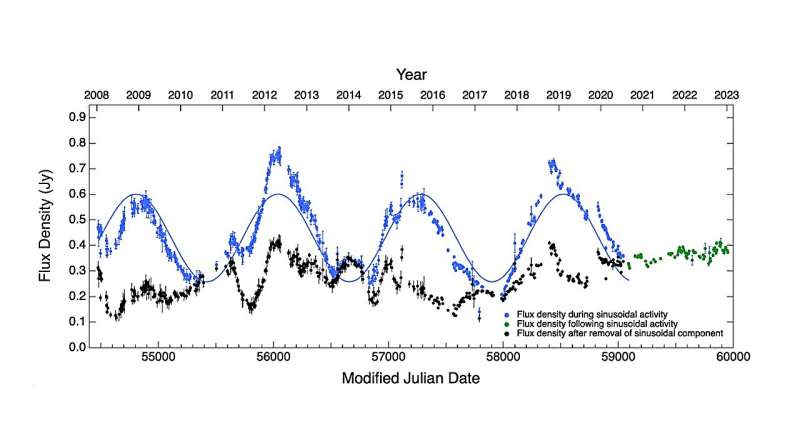August 13, 2024 report
This article has been reviewed according to Science X's editorial process and policies. Editors have highlighted the following attributes while ensuring the content's credibility:
fact-checked
preprint
trusted source
proofread
Astronomers detect a blazar exhibiting sinusoidal radio variability

An international team of astronomers reports the detection of a blazar with highly significant sinusoidal radio variability using the Owens Valley Radio Observatory (OVRO). The finding was detailed in a research paper published August 5 in the arXiv preprint repository.
Blazars are very compact quasars associated with supermassive black holes (SMBHs) at the centers of active, giant elliptical galaxies. They belong to a larger group of active galaxies that host active galactic nuclei (AGN), and are the most numerous extragalactic gamma-ray sources. Their characteristic features are relativistic jets pointed almost exactly toward the Earth.
Based on their optical emission properties, astronomers divide blazars into two classes: flat-spectrum radio quasars (FSRQs) that feature prominent and broad optical emission lines, and BL Lacertae objects (BL Lacs), which do not.
PKS J0805−0111 was first identified in 2007 as an FSRQ at a redshift of 1.39. Further observations of this blazar have suggested that it may contain a supermassive black hole binary (SMBHB).
Now, a group of astronomers, led by Philipe Vergara De La Parra of the University of Concepción in Chile, has employed OVRO to investigate the properties of PKS J0805−0111. As a result, they found that the blazar exhibits a peculiar behavior.
According to the paper, the 15 GHz light curve of PKS J0805−0111 shows a clear sinusoidal variation that dominates the variability for a significant fraction of the period of observation. This variation has a period of approximately 1.42 years, which turned out to be stable in long-term observational data.
The researchers explained that the observed periodicity can be attributed to the red noise tail of the power spectral density (PSD). They added that the detected sinusoidal radio variation of PKS J0805−0111 is additional to the regular variations of the blazar.
Furthermore, the astronomers found that the sinusoidal fluctuations disappeared in less than one period and also reappeared in less than one period, and with different amplitudes. Therefore, they predict that the sinusoidal variations will reappear in PKS J0805−0111 after a gap of some years, with the same period and in phase with the sinusoidal variations reported in the study.
Summing up the results, the authors of the paper underlined that the properties of the detected sinusoidal variations indicate that it may be a SMBHB blazar. If so, it would be the second SMBHB blazar showing sinusoidal variations in its radio light curve, after PKS 2131−021. However, further observations of PKS J0805−0111 are required in order to confirm this hypothesis.
"The discovery of a second SMBHB candidate exhibiting these rare characteristics reveals that PKS 2131−021 is not a unique, isolated case," the scientists concluded.
More information: P. V. de la Parra et al, PKS~J0805−0111: A Second Owens Valley Radio Observatory Blazar Showing Highly Significant Sinusoidal Radio Variability—The Tip of the Iceberg, arXiv (2024). DOI: 10.48550/arxiv.2408.02645
Journal information: arXiv
© 2024 Science X Network





















